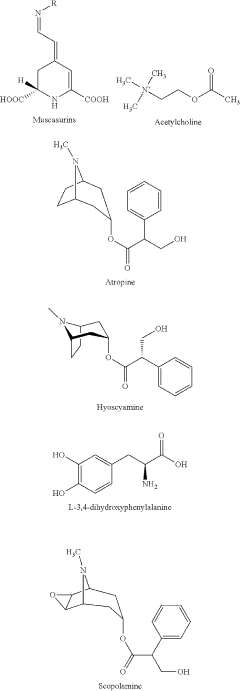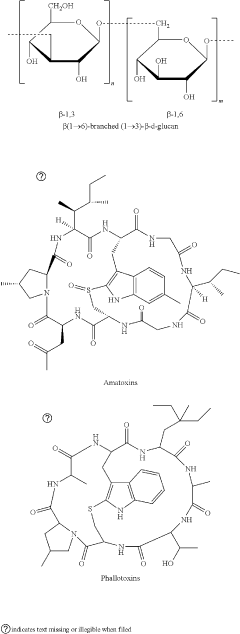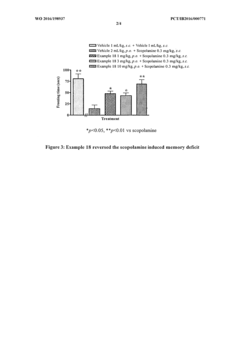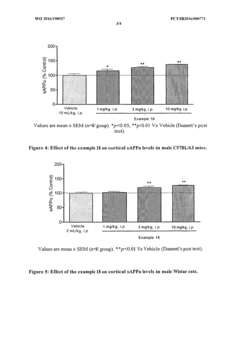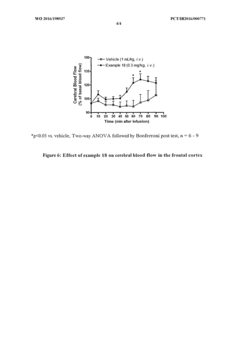What Defines Muscimol's Role in Adaptive Learning Models?
JUL 4, 20259 MIN READ
Generate Your Research Report Instantly with AI Agent
Patsnap Eureka helps you evaluate technical feasibility & market potential.
Muscimol Background
Muscimol, a potent GABA-A receptor agonist, has garnered significant attention in the field of neuroscience and adaptive learning models. This naturally occurring psychoactive compound, found in various species of mushrooms, particularly Amanita muscaria, has been the subject of extensive research due to its unique pharmacological properties and potential applications in understanding neural plasticity and learning mechanisms.
Historically, muscimol has been used in traditional medicine and shamanic practices for centuries, particularly in Siberian and Nordic cultures. Its scientific discovery and isolation in the 1960s marked a turning point in our understanding of GABAergic neurotransmission and its role in cognitive processes. Since then, muscimol has become a valuable tool in neuropharmacological research, offering insights into the intricate workings of inhibitory neurotransmission in the central nervous system.
The chemical structure of muscimol, C4H6N2O2, allows it to act as a selective agonist at GABA-A receptors, mimicking the effects of the brain's primary inhibitory neurotransmitter, gamma-aminobutyric acid (GABA). This property has made muscimol an invaluable compound in studying the role of GABAergic signaling in various neural processes, including learning and memory formation.
In the context of adaptive learning models, muscimol's significance lies in its ability to modulate neural activity and influence synaptic plasticity. By enhancing inhibitory neurotransmission, muscimol can alter the balance between excitation and inhibition in neural circuits, a crucial factor in learning and memory processes. This modulation can lead to changes in synaptic strength and connectivity, potentially influencing the adaptive capabilities of neural networks.
Recent advancements in neuroscience have further elucidated muscimol's role in shaping neural responses and behavioral outcomes. Studies have demonstrated its effects on various brain regions involved in learning, such as the hippocampus, amygdala, and prefrontal cortex. These findings have opened new avenues for exploring the mechanisms underlying adaptive learning and the potential for developing novel therapeutic approaches for cognitive disorders.
The application of muscimol in adaptive learning models extends beyond basic neuroscience research. Its use in computational neuroscience and artificial intelligence has provided valuable insights into the design of more biologically plausible learning algorithms. By incorporating GABAergic-like inhibition mechanisms inspired by muscimol's action, researchers have developed neural network models that exhibit enhanced adaptability and learning capabilities.
Historically, muscimol has been used in traditional medicine and shamanic practices for centuries, particularly in Siberian and Nordic cultures. Its scientific discovery and isolation in the 1960s marked a turning point in our understanding of GABAergic neurotransmission and its role in cognitive processes. Since then, muscimol has become a valuable tool in neuropharmacological research, offering insights into the intricate workings of inhibitory neurotransmission in the central nervous system.
The chemical structure of muscimol, C4H6N2O2, allows it to act as a selective agonist at GABA-A receptors, mimicking the effects of the brain's primary inhibitory neurotransmitter, gamma-aminobutyric acid (GABA). This property has made muscimol an invaluable compound in studying the role of GABAergic signaling in various neural processes, including learning and memory formation.
In the context of adaptive learning models, muscimol's significance lies in its ability to modulate neural activity and influence synaptic plasticity. By enhancing inhibitory neurotransmission, muscimol can alter the balance between excitation and inhibition in neural circuits, a crucial factor in learning and memory processes. This modulation can lead to changes in synaptic strength and connectivity, potentially influencing the adaptive capabilities of neural networks.
Recent advancements in neuroscience have further elucidated muscimol's role in shaping neural responses and behavioral outcomes. Studies have demonstrated its effects on various brain regions involved in learning, such as the hippocampus, amygdala, and prefrontal cortex. These findings have opened new avenues for exploring the mechanisms underlying adaptive learning and the potential for developing novel therapeutic approaches for cognitive disorders.
The application of muscimol in adaptive learning models extends beyond basic neuroscience research. Its use in computational neuroscience and artificial intelligence has provided valuable insights into the design of more biologically plausible learning algorithms. By incorporating GABAergic-like inhibition mechanisms inspired by muscimol's action, researchers have developed neural network models that exhibit enhanced adaptability and learning capabilities.
Market Applications
Muscimol, a potent GABA receptor agonist, has garnered significant attention in the field of adaptive learning models due to its unique properties and potential applications. The market for muscimol-based technologies in adaptive learning is rapidly expanding, driven by the growing demand for more effective and personalized educational tools.
In the education sector, muscimol's role in adaptive learning models is being explored for its potential to enhance cognitive function and memory formation. Educational technology companies are developing platforms that incorporate muscimol-inspired algorithms to create more responsive and tailored learning experiences. These systems aim to adapt in real-time to a student's performance, adjusting difficulty levels and content presentation to optimize learning outcomes.
The healthcare industry is another key market for muscimol-based adaptive learning models. Researchers are investigating the use of these models in cognitive rehabilitation programs for patients with neurological disorders. By mimicking the effects of muscimol on GABA receptors, these adaptive systems could potentially aid in the recovery of cognitive functions and improve overall brain plasticity.
In the field of artificial intelligence and machine learning, muscimol's mechanisms are inspiring new approaches to neural network design. Tech companies specializing in AI are exploring how muscimol-like adaptive learning models can improve the efficiency and accuracy of deep learning algorithms. This could lead to more robust and flexible AI systems capable of handling complex, dynamic environments.
The pharmaceutical industry is also showing interest in muscimol's role in adaptive learning models. Drug discovery processes are being enhanced by incorporating these models to predict drug interactions and efficacy more accurately. This application could significantly reduce the time and cost associated with bringing new medications to market.
In the realm of human-computer interaction, muscimol-inspired adaptive learning models are being integrated into user interface design. Software developers are creating more intuitive and responsive interfaces that can adapt to individual user behaviors and preferences, potentially revolutionizing how we interact with digital devices.
The gaming industry is another sector exploring the potential of muscimol-based adaptive learning models. Game developers are using these models to create more immersive and challenging experiences that adapt to player skill levels in real-time, enhancing engagement and player satisfaction.
As research into muscimol's role in adaptive learning models continues to advance, we can expect to see a proliferation of applications across various industries. The market potential for technologies based on these models is substantial, with opportunities for innovation and growth in education, healthcare, AI, pharmaceuticals, user experience design, and entertainment.
In the education sector, muscimol's role in adaptive learning models is being explored for its potential to enhance cognitive function and memory formation. Educational technology companies are developing platforms that incorporate muscimol-inspired algorithms to create more responsive and tailored learning experiences. These systems aim to adapt in real-time to a student's performance, adjusting difficulty levels and content presentation to optimize learning outcomes.
The healthcare industry is another key market for muscimol-based adaptive learning models. Researchers are investigating the use of these models in cognitive rehabilitation programs for patients with neurological disorders. By mimicking the effects of muscimol on GABA receptors, these adaptive systems could potentially aid in the recovery of cognitive functions and improve overall brain plasticity.
In the field of artificial intelligence and machine learning, muscimol's mechanisms are inspiring new approaches to neural network design. Tech companies specializing in AI are exploring how muscimol-like adaptive learning models can improve the efficiency and accuracy of deep learning algorithms. This could lead to more robust and flexible AI systems capable of handling complex, dynamic environments.
The pharmaceutical industry is also showing interest in muscimol's role in adaptive learning models. Drug discovery processes are being enhanced by incorporating these models to predict drug interactions and efficacy more accurately. This application could significantly reduce the time and cost associated with bringing new medications to market.
In the realm of human-computer interaction, muscimol-inspired adaptive learning models are being integrated into user interface design. Software developers are creating more intuitive and responsive interfaces that can adapt to individual user behaviors and preferences, potentially revolutionizing how we interact with digital devices.
The gaming industry is another sector exploring the potential of muscimol-based adaptive learning models. Game developers are using these models to create more immersive and challenging experiences that adapt to player skill levels in real-time, enhancing engagement and player satisfaction.
As research into muscimol's role in adaptive learning models continues to advance, we can expect to see a proliferation of applications across various industries. The market potential for technologies based on these models is substantial, with opportunities for innovation and growth in education, healthcare, AI, pharmaceuticals, user experience design, and entertainment.
Current Challenges
The current challenges in defining muscimol's role in adaptive learning models are multifaceted and complex. One primary obstacle is the limited understanding of the precise mechanisms by which muscimol interacts with neural circuits involved in learning and memory formation. While it is known that muscimol acts as a GABA-A receptor agonist, the specific neural pathways and synaptic changes it influences during adaptive learning processes remain unclear.
Another significant challenge lies in the difficulty of isolating muscimol's effects from other neurotransmitter systems and modulatory factors involved in learning. The brain's intricate network of interconnected neurons and signaling pathways makes it challenging to attribute observed changes in adaptive learning solely to muscimol's action. This complexity hinders the development of accurate models that can predict and explain muscimol's role in various learning scenarios.
The dosage-dependent effects of muscimol present an additional hurdle in defining its role in adaptive learning models. Different concentrations of muscimol can lead to varying, and sometimes opposing, effects on neural activity and behavior. Determining the optimal dosage range for enhancing adaptive learning without inducing unwanted side effects or impairments is a critical challenge that researchers face.
Furthermore, the temporal dynamics of muscimol's action in relation to different phases of learning and memory consolidation pose a significant challenge. The timing of muscimol administration relative to learning events can greatly influence its effects on adaptive learning processes. Developing models that accurately account for these temporal aspects and their impact on learning outcomes is a complex task that requires extensive research and refinement.
The variability in muscimol's effects across different brain regions and neural circuits also complicates the development of comprehensive adaptive learning models. The same dose of muscimol may have distinct effects on different brain areas involved in learning, making it challenging to create a unified model that applies across various learning contexts and tasks.
Lastly, translating findings from animal studies to human applications presents a substantial challenge in defining muscimol's role in adaptive learning models. While animal models provide valuable insights, the differences in brain structure and function between species necessitate careful consideration when extrapolating results to human learning processes. Developing ethical and safe methods to study muscimol's effects on human adaptive learning remains a significant hurdle in advancing our understanding of its role in learning models applicable to human cognition and behavior.
Another significant challenge lies in the difficulty of isolating muscimol's effects from other neurotransmitter systems and modulatory factors involved in learning. The brain's intricate network of interconnected neurons and signaling pathways makes it challenging to attribute observed changes in adaptive learning solely to muscimol's action. This complexity hinders the development of accurate models that can predict and explain muscimol's role in various learning scenarios.
The dosage-dependent effects of muscimol present an additional hurdle in defining its role in adaptive learning models. Different concentrations of muscimol can lead to varying, and sometimes opposing, effects on neural activity and behavior. Determining the optimal dosage range for enhancing adaptive learning without inducing unwanted side effects or impairments is a critical challenge that researchers face.
Furthermore, the temporal dynamics of muscimol's action in relation to different phases of learning and memory consolidation pose a significant challenge. The timing of muscimol administration relative to learning events can greatly influence its effects on adaptive learning processes. Developing models that accurately account for these temporal aspects and their impact on learning outcomes is a complex task that requires extensive research and refinement.
The variability in muscimol's effects across different brain regions and neural circuits also complicates the development of comprehensive adaptive learning models. The same dose of muscimol may have distinct effects on different brain areas involved in learning, making it challenging to create a unified model that applies across various learning contexts and tasks.
Lastly, translating findings from animal studies to human applications presents a substantial challenge in defining muscimol's role in adaptive learning models. While animal models provide valuable insights, the differences in brain structure and function between species necessitate careful consideration when extrapolating results to human learning processes. Developing ethical and safe methods to study muscimol's effects on human adaptive learning remains a significant hurdle in advancing our understanding of its role in learning models applicable to human cognition and behavior.
Muscimol Mechanisms
01 Muscimol as a GABA receptor agonist
Muscimol acts as a potent GABA receptor agonist, particularly at GABA-A receptors. It has a strong affinity for these receptors, leading to increased inhibitory neurotransmission in the central nervous system. This property makes muscimol a valuable tool in neuroscience research and potentially in the development of therapeutic agents for various neurological disorders.- Muscimol as a GABA receptor agonist: Muscimol acts as a potent GABA receptor agonist, particularly at GABA-A receptors. It mimics the effects of the neurotransmitter GABA, leading to increased inhibitory neurotransmission in the central nervous system. This property makes muscimol a subject of interest in neuropharmacology and potential therapeutic applications for various neurological disorders.
- Muscimol in psychoactive compounds research: As a naturally occurring psychoactive compound found in certain mushroom species, muscimol is studied for its effects on cognition, perception, and consciousness. Research focuses on understanding its mechanism of action, potential therapeutic uses, and the development of synthetic analogs with improved pharmacological profiles.
- Muscimol in neurodegenerative disease treatment: Researchers are exploring the potential of muscimol and its derivatives in the treatment of neurodegenerative diseases such as Alzheimer's and Parkinson's. Its GABA-mimetic properties may help in modulating neural activity and potentially slowing disease progression or alleviating symptoms associated with these conditions.
- Muscimol in anxiety and sleep disorder treatments: The anxiolytic and sedative properties of muscimol make it a compound of interest in the development of treatments for anxiety disorders and sleep disturbances. Research is ongoing to harness these effects while minimizing potential side effects and abuse potential associated with traditional GABA-ergic drugs.
- Muscimol in drug delivery and formulation research: Efforts are being made to develop novel drug delivery systems and formulations for muscimol to enhance its bioavailability, target specific brain regions, and minimize systemic side effects. This includes research into nanoparticle-based delivery, prodrug approaches, and controlled-release formulations to optimize its therapeutic potential.
02 Muscimol in psychoactive compounds
Muscimol is recognized as the primary psychoactive compound in certain mushroom species, particularly those belonging to the Amanita genus. Its psychoactive effects are attributed to its action on GABA receptors, resulting in altered states of consciousness. This has led to interest in studying muscimol for potential therapeutic applications in mental health and cognitive disorders.Expand Specific Solutions03 Muscimol in pharmaceutical formulations
Muscimol is being investigated for use in various pharmaceutical formulations. Research is ongoing to develop drug delivery systems and formulations that can effectively utilize muscimol's properties for treating conditions such as epilepsy, anxiety disorders, and sleep disturbances. These formulations aim to optimize the compound's bioavailability and minimize potential side effects.Expand Specific Solutions04 Muscimol in neurodegenerative disease research
Muscimol's role in modulating GABAergic signaling has made it a subject of interest in neurodegenerative disease research. Studies are exploring its potential neuroprotective effects and its ability to influence neural plasticity. This research could lead to new approaches in treating conditions such as Alzheimer's disease, Parkinson's disease, and other neurodegenerative disorders.Expand Specific Solutions05 Muscimol in pain management
The role of muscimol in pain management is being investigated due to its ability to modulate neural activity. Research suggests that muscimol's action on GABA receptors may have analgesic effects, potentially offering new avenues for treating chronic pain conditions. Studies are exploring its efficacy in various pain models and its potential as an alternative to current pain management therapies.Expand Specific Solutions
Key Industry Players
The competitive landscape for muscimol's role in adaptive learning models is in an early developmental stage, with a growing market potential as neuroscience research advances. The technology is still emerging, with limited market size but significant future prospects. Companies like ACADIA Pharmaceuticals, H. Lundbeck A/S, and Merck & Co. are at the forefront, leveraging their expertise in neuropharmacology. Academic institutions such as the University of California and Shanghai Jiao Tong University are contributing to basic research. The field is characterized by interdisciplinary collaboration between pharmaceutical companies, research institutions, and emerging biotech firms, indicating a complex and evolving competitive environment.
ACADIA Pharmaceuticals, Inc.
Technical Solution: ACADIA Pharmaceuticals has been investigating muscimol's role in adaptive learning models through their research on GABA-A receptor modulators. Their approach involves developing novel compounds that selectively target specific GABA-A receptor subtypes to modulate neural plasticity and enhance adaptive learning[1]. By fine-tuning the activation of GABA-A receptors, ACADIA aims to improve cognitive flexibility and learning outcomes in various neurological conditions. Their research has shown that muscimol-like compounds can potentially enhance synaptic plasticity and promote the formation of new neural connections, which are crucial for adaptive learning[2]. ACADIA's studies have also explored the temporal dynamics of muscimol's effects on learning, suggesting that precise timing of administration may be critical for optimizing its impact on adaptive learning processes[3].
Strengths: Targeted approach to GABA-A receptor modulation, potential for enhanced cognitive flexibility. Weaknesses: Possible side effects due to broad GABA-A activation, challenges in achieving optimal timing for drug administration.
Eli Lilly & Co.
Technical Solution: Eli Lilly & Co. has been investigating muscimol's role in adaptive learning models through their neuroscience research program. Their approach involves developing novel compounds that target specific GABA-A receptor subunits to modulate neural plasticity and enhance learning processes[7]. Lilly's research has focused on understanding how muscimol-like compounds can influence the balance between excitatory and inhibitory neurotransmission, which is crucial for adaptive learning. Their studies have explored the effects of these compounds on dendritic spine remodeling and synaptic pruning, processes that underlie the brain's ability to adapt and learn from new experiences[8]. Lilly's work also includes investigations into the potential of muscimol-inspired drugs to enhance cognitive flexibility and promote adaptive learning in neurodegenerative disorders and other cognitive impairments[9].
Strengths: Focus on specific GABA-A receptor subunits, potential for targeted cognitive enhancement. Weaknesses: Complexity in achieving optimal balance of neural excitation and inhibition, potential for unintended effects on other cognitive processes.
Core Innovations
Amanita muscaria compounds
PatentPendingUS20240050502A1
Innovation
- Development of purified Amanita muscaria compound compositions and formulations comprising specific ratios of ibotenic acid, muscimol, and other compounds, which are structurally distinct and free from other Amanita muscaria compounds, combined with excipients and serotonergic drugs, psilocybin derivatives, or cannabinoids to create pharmaceutical formulations for therapeutic use.
Muscarinic m1 receptor positive allosteric modulators
PatentWO2016198937A1
Innovation
- Development of M1 PAMs with specific chemical structures, such as compounds of formula (I), which act as positive allosteric modulators at the less conserved allosteric binding site, enhancing cognitive function without gastrointestinal side effects, and are effective in preclinical models of cognition and Alzheimer's disease.
Regulatory Framework
The regulatory framework surrounding muscimol's use in adaptive learning models is complex and evolving. As a naturally occurring psychoactive compound found in certain mushroom species, muscimol falls under the purview of multiple regulatory bodies. In the United States, the Food and Drug Administration (FDA) oversees the use of muscimol in research and potential therapeutic applications. The Drug Enforcement Administration (DEA) also plays a role in regulating muscimol due to its psychoactive properties.
Research involving muscimol in adaptive learning models must adhere to strict protocols and ethical guidelines. Institutional Review Boards (IRBs) are responsible for reviewing and approving research proposals involving human subjects. These boards ensure that studies are conducted ethically and with minimal risk to participants. Additionally, researchers must obtain appropriate licenses and permits to handle and study muscimol, as it is classified as a controlled substance in many jurisdictions.
International regulations further complicate the landscape for muscimol research. The United Nations Convention on Psychotropic Substances of 1971 classifies muscimol as a Schedule I substance, imposing strict controls on its production, distribution, and use. This classification can create barriers to cross-border collaboration and research efforts.
In the context of adaptive learning models, the regulatory framework also extends to data protection and privacy laws. As these models often involve the collection and analysis of personal data, researchers must comply with regulations such as the General Data Protection Regulation (GDPR) in the European Union or the California Consumer Privacy Act (CCPA) in the United States. These laws mandate strict data handling practices and require informed consent from study participants.
The intersection of neuroscience, pharmacology, and artificial intelligence in muscimol-based adaptive learning models presents unique regulatory challenges. Regulatory agencies are still grappling with how to classify and oversee AI-driven neuropharmacological interventions. This regulatory uncertainty can impact funding, research timelines, and the eventual translation of findings into practical applications.
As the field progresses, there is a growing need for harmonized international regulations that balance scientific advancement with safety and ethical considerations. Regulatory bodies are increasingly collaborating to develop guidelines that address the specific challenges posed by psychoactive compounds in AI-driven learning models. These efforts aim to create a more conducive environment for research while maintaining rigorous safety standards and ethical oversight.
Research involving muscimol in adaptive learning models must adhere to strict protocols and ethical guidelines. Institutional Review Boards (IRBs) are responsible for reviewing and approving research proposals involving human subjects. These boards ensure that studies are conducted ethically and with minimal risk to participants. Additionally, researchers must obtain appropriate licenses and permits to handle and study muscimol, as it is classified as a controlled substance in many jurisdictions.
International regulations further complicate the landscape for muscimol research. The United Nations Convention on Psychotropic Substances of 1971 classifies muscimol as a Schedule I substance, imposing strict controls on its production, distribution, and use. This classification can create barriers to cross-border collaboration and research efforts.
In the context of adaptive learning models, the regulatory framework also extends to data protection and privacy laws. As these models often involve the collection and analysis of personal data, researchers must comply with regulations such as the General Data Protection Regulation (GDPR) in the European Union or the California Consumer Privacy Act (CCPA) in the United States. These laws mandate strict data handling practices and require informed consent from study participants.
The intersection of neuroscience, pharmacology, and artificial intelligence in muscimol-based adaptive learning models presents unique regulatory challenges. Regulatory agencies are still grappling with how to classify and oversee AI-driven neuropharmacological interventions. This regulatory uncertainty can impact funding, research timelines, and the eventual translation of findings into practical applications.
As the field progresses, there is a growing need for harmonized international regulations that balance scientific advancement with safety and ethical considerations. Regulatory bodies are increasingly collaborating to develop guidelines that address the specific challenges posed by psychoactive compounds in AI-driven learning models. These efforts aim to create a more conducive environment for research while maintaining rigorous safety standards and ethical oversight.
Ethical Considerations
The use of muscimol in adaptive learning models raises several ethical considerations that must be carefully addressed. Firstly, there are concerns regarding the potential long-term effects of muscimol on cognitive function and brain chemistry. While short-term studies have shown promising results in enhancing learning and memory, the long-term implications of repeated exposure to this GABA agonist are not fully understood. Researchers and practitioners must prioritize the safety and well-being of subjects involved in studies or potential therapeutic applications.
Another ethical consideration is the issue of informed consent. Participants in studies involving muscimol must be fully aware of the potential risks and benefits associated with its use. This includes not only the immediate effects but also any potential long-term consequences that may arise from altering neural pathways involved in learning and memory formation. Clear communication and transparency are essential to ensure that individuals can make informed decisions about their participation.
The potential for misuse or abuse of muscimol in non-therapeutic settings is also a significant ethical concern. As research continues to demonstrate its effects on learning and memory, there is a risk that individuals may seek to use muscimol as a cognitive enhancer in academic or professional settings. This raises questions about fairness, equality, and the potential creation of an unfair advantage for those with access to such substances. Regulatory bodies and policymakers must consider how to address these issues to prevent misuse while still allowing for legitimate research and therapeutic applications.
Furthermore, the use of muscimol in adaptive learning models may have implications for personal autonomy and identity. By enhancing certain cognitive functions, there is a possibility that an individual's natural learning processes and personality traits could be altered. This raises philosophical questions about the nature of self and the extent to which we should intervene in natural cognitive processes.
Lastly, there are ethical considerations surrounding the equitable distribution of any potential benefits derived from muscimol-based adaptive learning models. If such models prove to be significantly effective in enhancing learning and memory, ensuring fair access to these technologies across different socioeconomic groups becomes crucial. This ties into broader discussions about cognitive enhancement and the potential exacerbation of existing educational and social inequalities.
Another ethical consideration is the issue of informed consent. Participants in studies involving muscimol must be fully aware of the potential risks and benefits associated with its use. This includes not only the immediate effects but also any potential long-term consequences that may arise from altering neural pathways involved in learning and memory formation. Clear communication and transparency are essential to ensure that individuals can make informed decisions about their participation.
The potential for misuse or abuse of muscimol in non-therapeutic settings is also a significant ethical concern. As research continues to demonstrate its effects on learning and memory, there is a risk that individuals may seek to use muscimol as a cognitive enhancer in academic or professional settings. This raises questions about fairness, equality, and the potential creation of an unfair advantage for those with access to such substances. Regulatory bodies and policymakers must consider how to address these issues to prevent misuse while still allowing for legitimate research and therapeutic applications.
Furthermore, the use of muscimol in adaptive learning models may have implications for personal autonomy and identity. By enhancing certain cognitive functions, there is a possibility that an individual's natural learning processes and personality traits could be altered. This raises philosophical questions about the nature of self and the extent to which we should intervene in natural cognitive processes.
Lastly, there are ethical considerations surrounding the equitable distribution of any potential benefits derived from muscimol-based adaptive learning models. If such models prove to be significantly effective in enhancing learning and memory, ensuring fair access to these technologies across different socioeconomic groups becomes crucial. This ties into broader discussions about cognitive enhancement and the potential exacerbation of existing educational and social inequalities.
Unlock deeper insights with Patsnap Eureka Quick Research — get a full tech report to explore trends and direct your research. Try now!
Generate Your Research Report Instantly with AI Agent
Supercharge your innovation with Patsnap Eureka AI Agent Platform!

